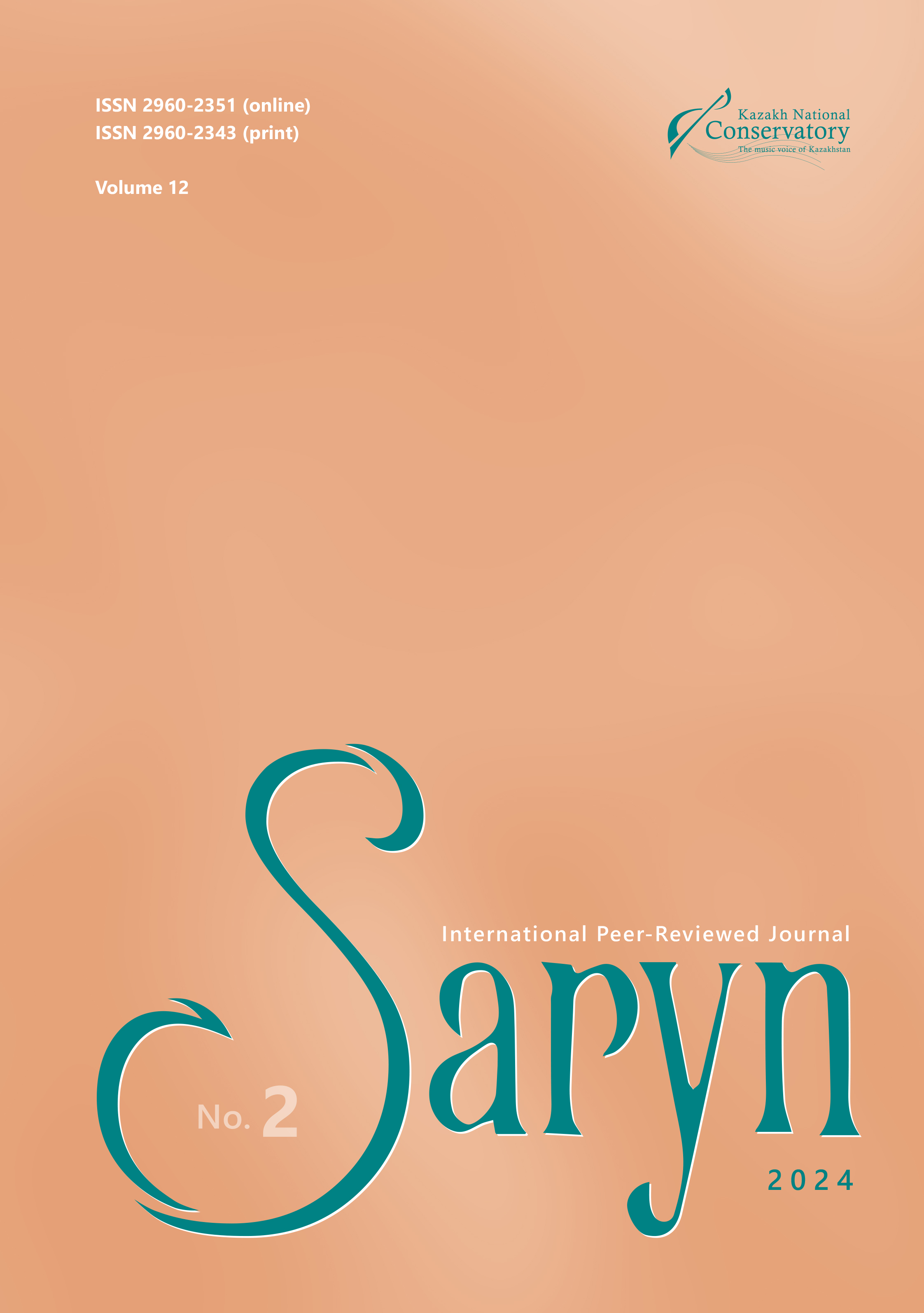Article information
Article publication date
2024-06-25
Article Page
40–53
Chapter
Arts & Humanities
License
Abstract
The presented article is devoted to the analysis of the vocal part of Abai from the same-name opera by Latif Hamidi and Akhmet Zhubanov using the method of intertextuality. The study is conducted in the context of the rich traditional culture of Kazakhstan, including musical, literary and semantic aspects of the opera part. The authors of the article turn to modern theoretical concepts of intertextuality to analyze the connections between the musical elements of opera and various cultural texts. Special attention is paid to intertextual references in Abai’s vocal part, which makes it possible to understand the deep context and semantic load of the musical utterances of the main character. The authors turn to numerous sources, including contemporary studies in the field of musicology, opera and culture, to present a deeper analysis of the “Abai” opera and its place in cultural context. The results of the study help not only to understand the complex structure and content of opera, but also to expand the awareness of how the intertextuality method can contribute to a deeper analysis of musical works.
The work is based on the theory of intertextuality and includes the analysis of musical, literary and cultural aspects of the opera. A comparison of Abai’s vocal part with folk songs, poetic works and historical plots is carried out. Also, intertextual connections were revealed, as well as its correlation with the cultural heritage of Kazakhstan. The influence of the national musical heritage on the creation of the opera is discussed. The results of the analysis are presented, which make it possible to expand the understanding of the “Abai” opera in the context of the opera art of Kazakhstan.
The conclusions of the study emphasize the importance of using the intertextuality method for in-depth analysis of opera music. The article contributes to the development of the research direction and fosters to a deeper comprehention of the cultural significance of the “Abai” opera.
Keywords
traditional culture
opera art
intertextuality
vocal part
Abai
cultural context
cultural heritage
References
Akhmet Zhubanov. Edited by Nurgiyan Ketegenova and Aklima Omarova. Almaty, Oner, 2006. (In Kazakh)
Beisaliyeva, Dina. “Nekotorye dramaturgicheskie principy opery ‘Abaj’ A. Zhubanova, L. Hamidi.” [“Some Dramatic Principles of the ‘Abai’ Opera by A. Zhubanov and L. Hamidi.”] Ahmet Zhubanov: sbornik statej [Akhmet Zhubanov: Collection of Articles]. Edited by Nurgiyan Ketegenova and Aklima Omarova. Almaty, Oner, 2006, pp. 146–153. (In Russian)
Gasparov, Mikhail. “Literaturnyj intertekst i yazykovoj intertekst.” [“Literary Intertextuality and Linguistic Intertextuality.”]. Izvestiya RAN, Serija literatury i jazyka, vol. 61, no. 4, 2002, pp. 3–9. (In Russian)
Gorlée, Dinda. “Intersemioticity and Intertextuality: Picaresque and Romance in Opera.” Sign Systems Studies, vol. 44, no. 4, 2016, pp. 587–622. DOI: 10.12697/SSS.2016.44.4.06.
Jumakova, Umitzhan. Tvorchestvo kompozitorov Kazaxstana 1920–1980-h godov. Problemy istorii, smysla i cennosti [The Works of Kazakhstan’s Composers in 1920–1980s. Problems of History, Meaning and Value]. Astana, Foliant, 2003. (In Russian)
Kristeva, Julia. “Tekst romana.” [“The Novel Text.”]. Izbrannye trudy: Razrushenie poetiki [Selected Works: A Destruction of Poetics]. Transl. from French Georgiy Kosikov and Boris Narumov. Moscow, ROSSPEN, 2004, p. 395–593. (In Russian)
Kuzembayeva, Sara. Nacionalnye xudozhestvennye tradicii i ix konvergentnost v zhanre kazaxskoj opery [National Artistic Traditions and their Convergence in the Genre of Kazakh Opera]. Almaty, s. n., 2006. (In Russian)
Latif Khamidi. Edited by Aklima Omarova. Almaty, Oner, 2006. (In Kazakh)
Moskvin, Vassiliy. “Metodika intertekstualnogo analiza.” [“The Method of Intertextual Analysis.”] Izvestiya Volgogradskogo gosudarstvennogo pedagogicheskogo universiteta, no. 3 (98), 2015, pp. 116–121. (In Russian)
Musakhodzhayeva, Saule. Kollektivnoe avtorstvo v kazaxskoj opere [Collective Authorship in the Kazakh Opera], 2020. Nur-Sultan, Kazakh National University of Arts, PhD thesis.
Rakisheva, Diana, et al. “Philosophy of the Intertextuality as a Method of Studying the ‘Kyz Zhibek’ Opera.” Bulletin of L. N. Gumilyov Eurasian National University. Historical Sciences. Philosophy. Religious Studies Series, vol. 145, no. 4, 2023, pp. 286–299. DOI: 10.32523/2616-7255-2023-145-4-286-299.
Sebeok, Thomas. “Enter Textuality: Echoes from the Extra-Terrestrial.” Poetics Today, vol. 6, no. 4, 1985, рр. 657–663. DOI: 10.2307/1771959.
Yerzakovich, Boris. “Nekotorye kommentarii k ‘Vospominaniyam’ (dnevnikam Ye. Brusilovskogo).” [“Some Comments on the ‘Memoirs’ (Diaries of Ye. Brusilovsky).”] Evgenij Brusilovskij: sbornik statej, ocherkov, vospominanij [Yevgeniy Brusilovsky: Collection of Articles, Essays and Memories]. Edited by Nurgiyan Ketegenova, Almaty, Oner, 2005, pp. 103–114. (In Russian)




